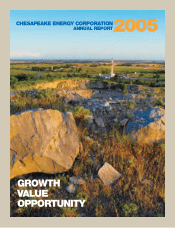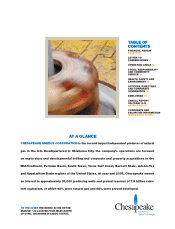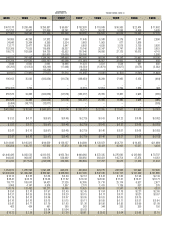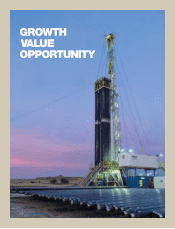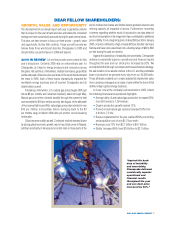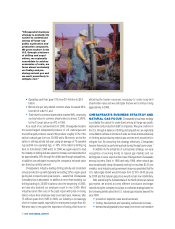Chesapeake Energy 2005 Annual Report Download - page 8
Download and view the complete annual report
Please find page 8 of the 2005 Chesapeake Energy annual report below. You can navigate through the pages in the report by either clicking on the pages listed below, or by using the keyword search tool below to find specific information within the annual report.
•Operating cash flow2
grew 73% from $1.4 billion to $2.4
billion;
•Net income per fully diluted common share increased 64%
from $1.53 to $2.51; and
•Total return to common shareholders reached 94%, improving
our total return to common shareholders to almost 2,300%
for the 13 years since our IPO in 1993.
As a result of our achievements in 2005, Chesapeake became
the second largest independent producer of U.S. natural gas and
the sixth largest producer overall. We produce roughly 2.5% of the
nation’s natural gas from our 30,000 wells. Moreover, we led the
nation in drilling activity last year, using an average of 73 operated
rigs and 66 non-operated rigs, or 10% of the nation’s drilling rig
fleet, to drill almost 2,000 wells. In 2006, we again expect to lead
the industry in drilling and also expect to increase our total production
by approximately 25% through the drillbit and through acquisitions.
In addition, we anticipate increasing the company’s net asset value
per share by a similar amount.
Chesapeake’s industry-leading drilling activity and consistent
annual production growth (typically exceeding 25%) require great
geological prospects and great people – assets that Chesapeake
fortunately has in abundance. In addition to more than doubling our
drilling backlog to 28,000 locations since the beginning of 2005,
we have also doubled our employee count to over 3,500. Most
industries (and often ours in the past) report with pride on being
able to reduce their employee head count each year. However, after
15 difficult years from 1985 to 2000, our industry is increasingly
short on human capital, especially for employees younger than 40.
We were early to recognize the importance of being a first mover in
attracting the human resources necessary to create long-term
shareholder value and we anticipate that we will continue hiring
aggressively in 2006.
CHESAPEAKE’S BUSINESS STRATEGY AND
NATURAL GAS FOCUS Chesapeake’s business strategy
is probably the easiest to understand among all large-cap public
exploration and production (E&P) companies. We grow onshore in
the U.S. through a balance of drilling and acquisitions, we regionally
consolidate to achieve economies of scale, we focus almost exclusively
on finding and producing natural gas and we work proactively to
mitigate risk. By executing this strategy effectively, Chesapeake
became America’s top performing stock during the past seven years.3
In addition to the simplicity of our business strategy, our early
recognition of evolving trends in natural gas markets and our
willingness to seize opportunities have distinguished Chesapeake
among its peers. Back in 1998 and early 1999, when natural gas
was exceptionally cheap (frequently selling for less than $1.25 per
mmbtu), most industry and government observers predicted that the
U.S. natural gas market would increase from 22 tcf to 30 tcf per year
by 2010 and that natural gas prices would remain low indefinitely.
After examining the fundamentals of the North American natural
gas market, we arrived at a very different conclusion and began
repositioning the company to pursue a contrarian strategy based on
the following beliefs about the U.S. natural gas industry beyond the
year 2000:
•production depletion rates would accelerate;
•finding, development and operating costs would increase;
•demand would gradually move away from more cost-sensitive
“Chesapeake’s business
strategy is probably the
easiest to understand
among all large-cap
public exploration and
production companies.
We grow onshore in the
U.S. through a balance
of drilling and acqui-
sitions, we regionally
consolidate to achieve
economies of scale, we
focus almost exclusively
on finding and pro-
ducing natural gas and
we work proactively to
mitigate risk.”
4 CHK 2005 ANNUAL REPORT

